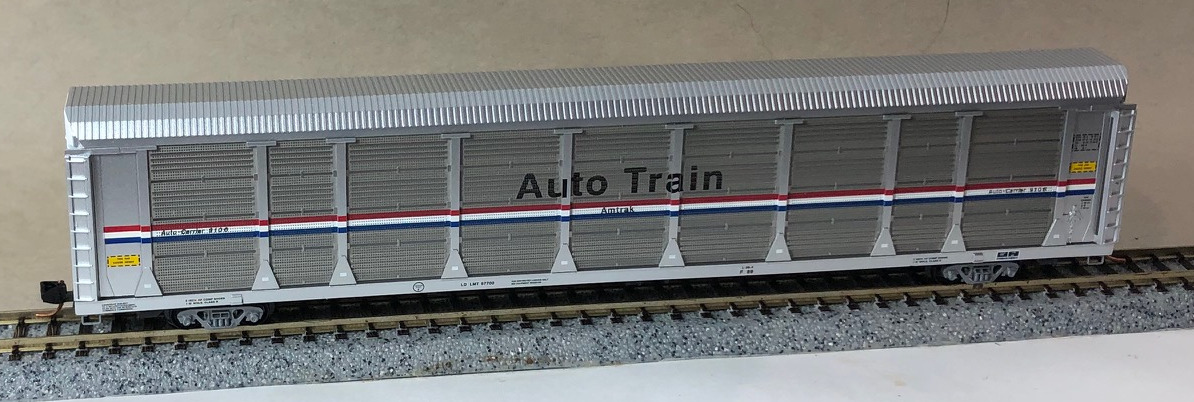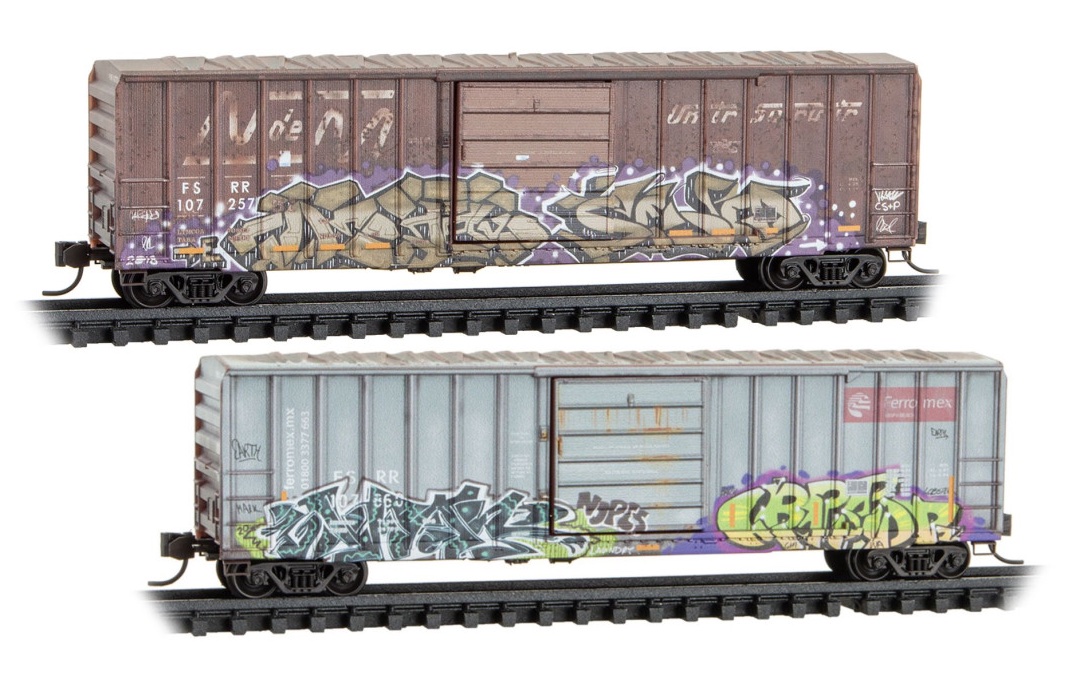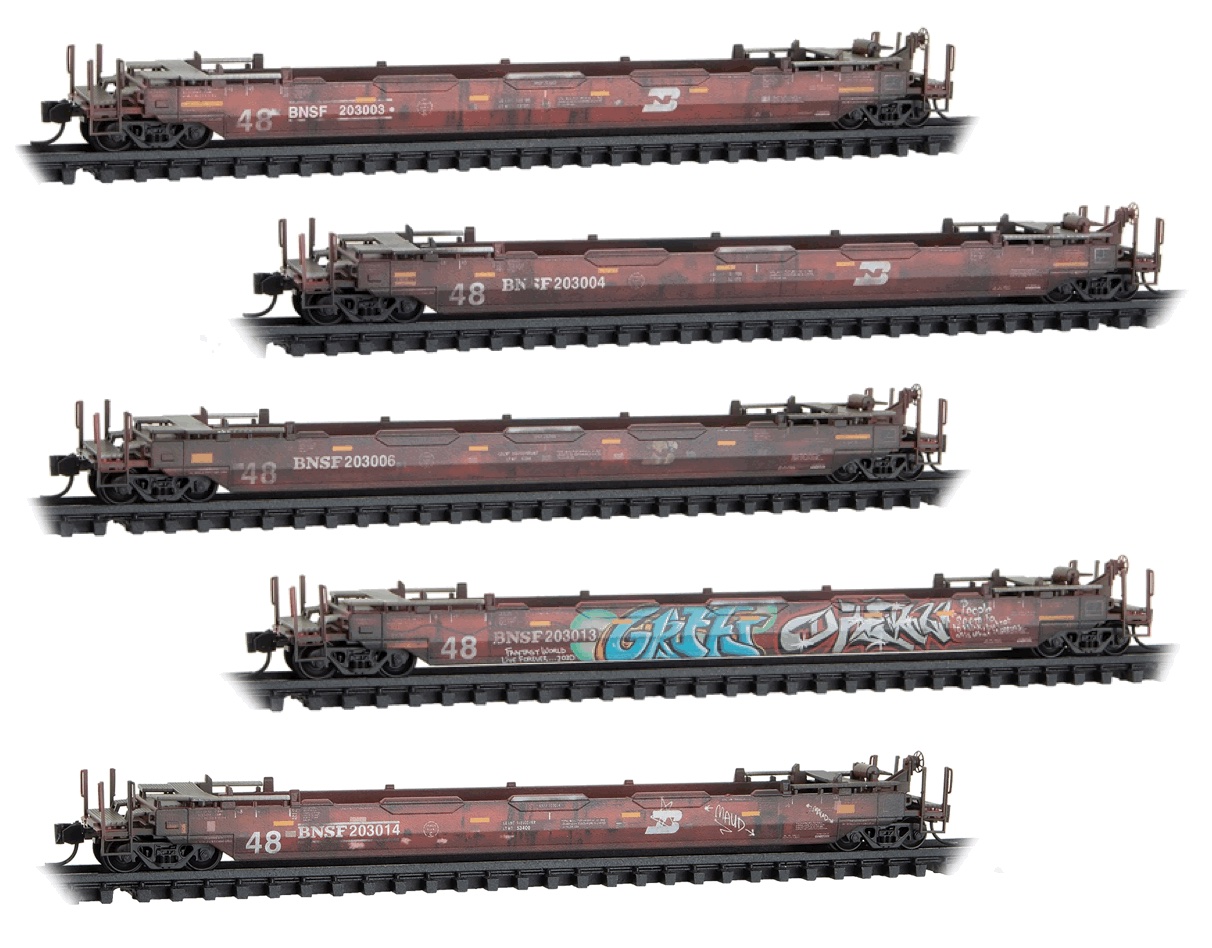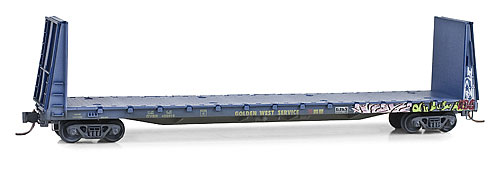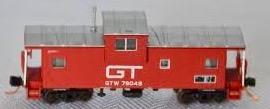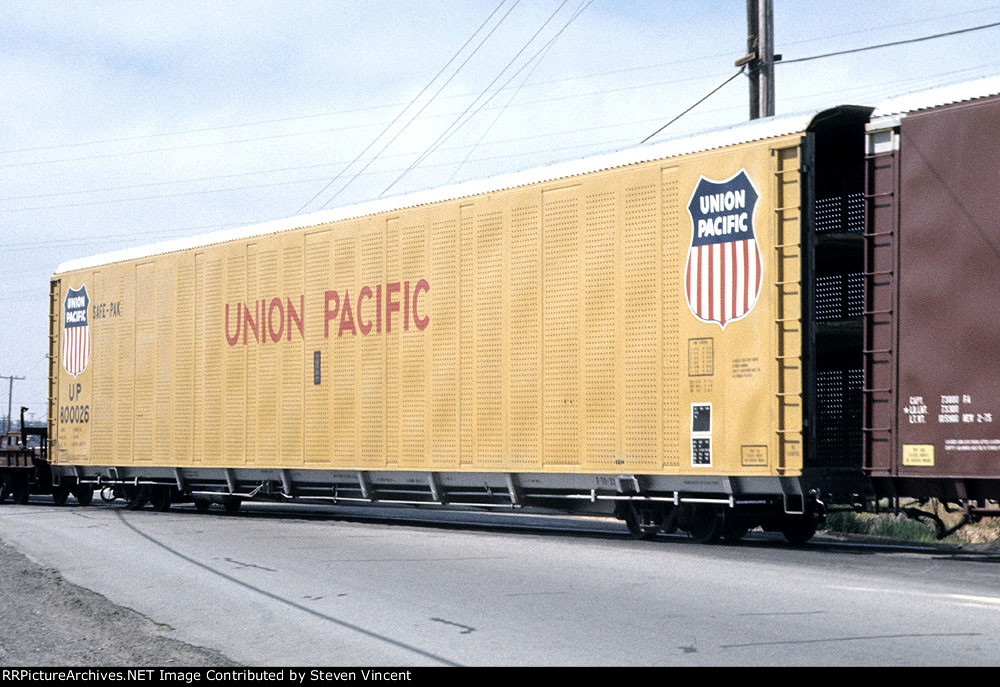Prototype History: For many years, automobiles were carried in boxcars like other freight. The relative light weight of the cars for their size meant that these boxcars reached their volume capacity far faster than their weight limit. Loading cars through the side doors was also challenging and inefficient. End door boxcars helped with the loading, but could still only be loaded one at a time. Due to these limitations, modified flatcars, known as autoracks, began to appear in the 1960s. At first, these cars were open sided, with the cargo exposed, but later cars added the protection of aluminum sides to enclose the automobiles within.
Enclosed autoracks come in two basic configurations. Bi-level racks have a two decks: the floor of the flatcar itself, as well as one elevated deck. These cars can haul two rows of taller vehicles like vans and trucks. Tri-level racks have an extra deck and can carry three rows of conventional automobiles. Up until the 1990s, tri-level cars were far more common, but with the rise in popularity of the SUV, the number of bi-level cars has grown quickly over the past 20 years.
Enclosed autoracks come in two basic configurations. Bi-level racks have a two decks: the floor of the flatcar itself, as well as one elevated deck. These cars can haul two rows of taller vehicles like vans and trucks. Tri-level racks have an extra deck and can carry three rows of conventional automobiles. Up until the 1990s, tri-level cars were far more common, but with the rise in popularity of the SUV, the number of bi-level cars has grown quickly over the past 20 years.
Road Name History: 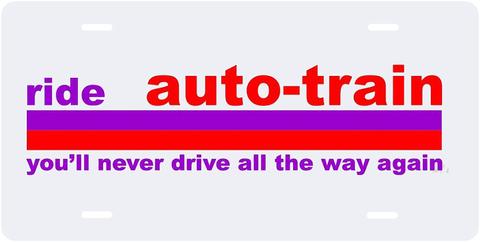 Auto-Train was incorporated in 1969 and began operations in late 1971. Initially, they hauled passengers and their automobiles from Lorton in Northern Virginia to Sanford, Florida which is not far from Orlando. RF&P and Seaboard Coast Line were the host railroads. The passenger car fleet was purchased secondhand from various roads and the autoracks were an early design from Canadian National. GE U36B's were used for road power (built to Seaboard Coast Line specifications.) Lorton was the northern terminus because the autoracks would not fit the clearances in Washington D.C. and points north. Auto-Train featured daily departures from both ends. The trains were popular and usually exceeded 30 cars evenly split between autoracks and passenger cars. In 1974, Auto-Train expanded with trains running between Louisville and Sanford. This second route was a failure and this combined with a couple of expensive wrecks sent Auto-Train into a downward spiral. In 1980, they declared bankruptcy and the following April, the last Auto-Train ran. Amtrak resurrected the idea in 1983 with a tri-weekly service on the Lorton - Sanford route.
Auto-Train was incorporated in 1969 and began operations in late 1971. Initially, they hauled passengers and their automobiles from Lorton in Northern Virginia to Sanford, Florida which is not far from Orlando. RF&P and Seaboard Coast Line were the host railroads. The passenger car fleet was purchased secondhand from various roads and the autoracks were an early design from Canadian National. GE U36B's were used for road power (built to Seaboard Coast Line specifications.) Lorton was the northern terminus because the autoracks would not fit the clearances in Washington D.C. and points north. Auto-Train featured daily departures from both ends. The trains were popular and usually exceeded 30 cars evenly split between autoracks and passenger cars. In 1974, Auto-Train expanded with trains running between Louisville and Sanford. This second route was a failure and this combined with a couple of expensive wrecks sent Auto-Train into a downward spiral. In 1980, they declared bankruptcy and the following April, the last Auto-Train ran. Amtrak resurrected the idea in 1983 with a tri-weekly service on the Lorton - Sanford route.

Brand/Importer Information: Micro-Trains is the brand name used by both Kadee Quality Products and Micro-Trains Line. For a history of the relationship between the brand and the two companies, please consult our Micro-Trains Collector's Guide.
Manufacturer Information:  Micro-Trains Line split off from Kadee Quality Products in 1990. Kadee Quality Products originally got involved in N-Scale by producing a scaled-down version of their successful HO Magne-Matic knuckle coupler system. This coupler was superior to the ubiquitous 'Rapido' style coupler due to two primary factors: superior realistic appearance and the ability to automatically uncouple when stopped over a magnet embedded in a section of track. The success of these couplers in N-Scale quickly translated to the production of trucks, wheels and in 1972 a release of ready-to-run box cars.
Micro-Trains Line split off from Kadee Quality Products in 1990. Kadee Quality Products originally got involved in N-Scale by producing a scaled-down version of their successful HO Magne-Matic knuckle coupler system. This coupler was superior to the ubiquitous 'Rapido' style coupler due to two primary factors: superior realistic appearance and the ability to automatically uncouple when stopped over a magnet embedded in a section of track. The success of these couplers in N-Scale quickly translated to the production of trucks, wheels and in 1972 a release of ready-to-run box cars.
Micro-Trains Line Co. split off from Kadee in 1990 to form a completely independent company. For this reason, products from this company can appear with labels from both enterprises. Due to the nature of production idiosyncrasies and various random factors, the rolling stock from Micro-Trains can have all sorts of interesting variations in both their packaging as well as the products themselves. When acquiring an MTL product it is very important to understand these important production variations that can greatly enhance (or decrease) the value of your purchase.
Please consult our Micro-Trains Collector's Guide

Micro-Trains Line Co. split off from Kadee in 1990 to form a completely independent company. For this reason, products from this company can appear with labels from both enterprises. Due to the nature of production idiosyncrasies and various random factors, the rolling stock from Micro-Trains can have all sorts of interesting variations in both their packaging as well as the products themselves. When acquiring an MTL product it is very important to understand these important production variations that can greatly enhance (or decrease) the value of your purchase.
Please consult our Micro-Trains Collector's Guide
Commissioner Information: Brooklyn Locomotive Works was a hobby shop, specialized in N-scale, located in Manalapan, New Jersey, that also sells on-line. BLW regularly commissions special runs.
The company was founded by Pete Postel who announced that he would retired by end of 2018. His brother Paul should continue the business from his own shop Hogtrainz.com.
Brooklyn Locomotive Works (BLW) released special runs from various manufacturers under its own brand until approx. the mid-1980s. Thereafter the special runs where sold under the manufacturer's name and denoted as special runs for BLW. Hence in this database, we assign the BLW brand in the former case, and the original manufacturer's brand in the latter.
The company was founded by Pete Postel who announced that he would retired by end of 2018. His brother Paul should continue the business from his own shop Hogtrainz.com.
Brooklyn Locomotive Works (BLW) released special runs from various manufacturers under its own brand until approx. the mid-1980s. Thereafter the special runs where sold under the manufacturer's name and denoted as special runs for BLW. Hence in this database, we assign the BLW brand in the former case, and the original manufacturer's brand in the latter.
Item created by: Appin House on 2019-10-03 11:43:22. Last edited by gdm on 2020-05-11 14:24:01
If you see errors or missing data in this entry, please feel free to log in and edit it. Anyone with a Gmail account can log in instantly.
If you see errors or missing data in this entry, please feel free to log in and edit it. Anyone with a Gmail account can log in instantly.


